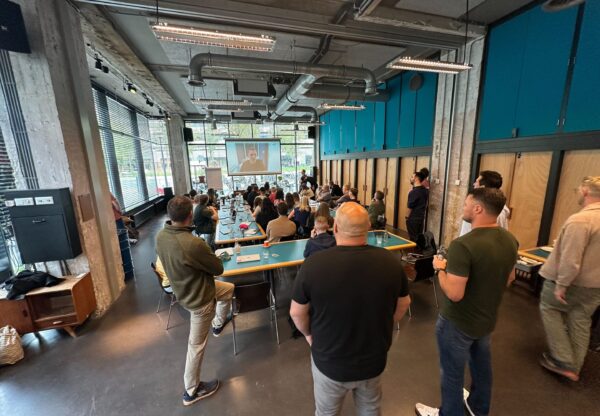In today’s fast-paced work environment, fostering a cohesive and motivated team is more important than ever. Effective work group activities, including corporate team building activities, not only enhance collaboration and boost morale but also improve overall productivity. Whether you’re part of a small startup or a large corporation, incorporating creative and engaging activities into your team’s routine can lead to significant growth and success.
Let’s dive into a range of dynamic team-building exercises designed to energize your team and unlock their full potential.
1. The Marshmallow challenge: Building success, one spaghetti stick at a time
Imagine your team in a room, surrounded by spaghetti sticks, tape, string, and a single marshmallow. The objective? Build the tallest free-standing structure with the marshmallow on top within 18 minutes. Though it seems very simple, it can actually be quite hard. It forces team members to collaborate very quickly.

Benefits:
- Teams must think outside the box to create a stable structure.
- Prototyping and testing designs lead to better performance, emphasizing iterative processes.
- Clear communication and collaboration are essential for success.
Rules:
- Teams are given the materials and 18 minutes to construct their structure.
- The marshmallow must be placed on top of the structure.
- The structure must be free-standing and cannot be supported by anything other than the provided materials.
- No additional tools or materials are allowed.
Example in Action: At a tech startup, the Marshmallow Challenge was an excellent icebreaker during onboarding, highlighting the importance of rapid prototyping and sparking insightful discussions about refining their product development process.
2. Blind square rope Game: Navigating communication with eyes closed
In this game, participants are blindfolded and given a rope, tasked with forming a perfect square without seeing. This activity emphasizes:
- Enhanced communication: Teams rely on verbal instructions, honing their communication skills.
- Trust building: Blindfolds create an environment of trust and dependency.
- Leadership development: Natural leaders emerge as they guide their blindfolded teammates.
Real-World Example: A manufacturing company used this activity at a leadership retreat to showcase the importance of clear communication and trust, leading to a more unified approach to organizational goals.
Thinking about planning a company retreat?
Our Budget Estimator, powered by data from 3,000+ retreats, provides an estimated team trip cost in seconds.
3. Personal kanban: Visualizing success one task at a time
Personal Kanban involves using a visual board with columns like To Do, In Progress, and Done to manage tasks. It’s a fantastic way to:
- Boost productivity: Visualizing tasks helps manage workloads more effectively.
- Reduce stress: Clear task visualization alleviates the stress of juggling multiple responsibilities.
- Enhance collaboration: Teams can easily track progress and collaborate on tasks.
Success Story: A marketing team adopted Personal Kanban to streamline their campaign tasks, reducing bottlenecks, improving workflow, and significantly boosting overall productivity.
4. Heard, seen, respected (HSR): Building empathy through shared stories
The Heard, Seen, Respected (HSR) activity is a powerful exercise in empathy and active listening. Team members share personal stories about times they felt unheard or unappreciated, followed by a group reflection. Benefits of this activity:
- Fosters empathy: Sharing personal experiences deepens understanding among team members.
- Enhances listening skills: Encourages active listening and validation of others’ experiences.
- Strengthens trust: Creates a safe space for open, honest communication.
Application in diversity: During a company-wide diversity and inclusion workshop, HSR helped employees share their experiences, leading to stronger bonds and a deeper understanding among team members.
5. Daily scrum meetings: Keeping teams aligned and accountable
Daily Scrum meetings, or stand-ups, are brief gatherings where team members discuss their progress, plans, and any obstacles. Benefits of this routine:
- Improves alignment: Keeps everyone on the same page with team goals.
- Facilitates problem-solving: Quickly identifies and addresses obstacles.
- Boosts accountability: Regular updates increase individual accountability.
Agile enhancement: A software development team incorporated daily stand-ups to enhance their Agile processes, leading to faster development cycles and higher-quality software.
6. LEGO challenge: Building creativity brick by brick
Teams use LEGO bricks to tackle specific problems or challenges. This playful activity:
- Fosters creativity: Encourages innovative thinking and problem-solving.
- Enhances collaboration: Requires teamwork to build effective solutions.
- Promotes playfulness: A fun way to break down barriers and build a positive team environment.
Design innovation: An architecture firm used the LEGO Challenge in a brainstorming session, leading to several innovative ideas for their projects.
7. Playing with status: Exploring power dynamics through role-play
Playing with Status involves role-playing scenarios with varying power dynamics, helping teams understand how different status levels affect interactions. This role-play activity:
- Improves communication: Highlights how power dynamics impact communication.
- Encourages reflection: Helps participants reflect on their communication styles.
- Promotes inclusivity: Fosters a more inclusive and understanding workplace culture.
Consulting success: A consulting firm used this activity to address hierarchical communication issues, resulting in improved communication and a more inclusive environment.
8. Crocodile river: Crossing challenges with creative solutions
Teams must cross an imaginary river filled with “crocodiles” using limited resources.
Benefits:
- Enhances problem-solving: Requires creative strategies to navigate challenges.
- Builds teamwork: Teams must collaborate to devise and execute a plan.
- Encourages leadership: Highlights natural leaders within the group.
Engineering Achievement: An engineering team used the Crocodile River exercise to improve problem-solving and teamwork, developing better strategies for complex projects.
9. Minefield: Navigating trust and communication blindfolded
In Minefield, participants navigate an obstacle course while blindfolded, relying on their teammates’ instructions. This mind-bending navigation game:
- Builds trust: Encourages reliance on team members for guidance.
- Improves communication: Requires clear and effective instructions.
- Fosters team bonding: A fun way to strengthen team relationships.
10. Agile clock: Visualizing agile principles
Teams summarize Agile principles in three words and visualize them on a clock. A creative way to:
- Enhances understanding: Helps teams internalize Agile principles.
- Improves communication: Encourages discussion and reflection on Agile practices.
- Facilitates adoption: Aids in the smooth implementation of Agile methodologies.
Product development: A product development team used Agile Clock to better understand and implement Agile practices, leading to more efficient workflows.
11. Escape room challenge: Solving puzzles under pressure
Escape rooms are immersive experiences where teams solve puzzles to “escape” within a set time. A fun approach to:
- Enhances problem-solving: Requires critical thinking and teamwork.
- Builds teamwork: Teams work together under pressure to achieve their goal.
- Encourages communication: Effective communication is essential for success.
Finance team bonding: A finance team participated in an escape room challenge, boosting their problem-solving abilities and enhancing team cohesion.
12. Charity team building: Making a difference together
Charity team building combines community service with team bonding. A powerful tool to:
- Fosters bonding: Working together for a good cause strengthens relationships.
- Enhances morale: Contributing to the community boosts job satisfaction.
- Promotes CSR: Aligns with the company’s corporate social responsibility initiatives.
Healthcare Initiative: A healthcare company organized a charity event where employees volunteered at a local shelter, improving team cohesion and boosting morale.
13. Innovation workshops: Sparking creativity and new ideas
Innovation workshops are sessions where teams brainstorm and develop new ideas. This activity:
- Fosters creativity: Provides a platform for innovative thinking.
- Encourages collaboration: Teams work together to refine ideas.
- Drives innovation: Can lead to new products or process improvements.
Retail Revolution: A retail company held an innovation workshop to improve customer experience, resulting in actionable ideas that were later implemented.

14. Virtual work group activities: Connecting remote teams
Virtual team building activities are designed for remote teams and can include online escape rooms, trivia games, and more. A quick way to:
- Builds remote cohesion: Strengthens relationships in remote teams.
- Enhances communication: Encourages effective communication across distances.
- Fosters inclusivity: Ensures remote team members feel valued and included.
Global marketing success: A global marketing team organized a virtual trivia night, improving team bonding and communication across different time zones.
15. Outdoor adventure activities: Bonding in nature
Outdoor adventures like hiking, kayaking, or zip-lining provide a break from the office environment and promote team bonding. Benefits of this activity:
- Builds cohesion: Shared outdoor experiences strengthen team bonds.
- Encourages collaboration: Teams work together to overcome physical challenges.
- Promotes well-being: Physical activity in nature enhances overall well-being.
Corporate hiking: A corporate team went on a hiking trip to boost morale and teamwork, leading to stronger relationships and a renewed sense of purpose.

Boost team morale and cohesion with effective team building activities
Incorporating a variety of team-building activities into your workplace routine can significantly enhance team morale and cohesion. These activities help identify natural leaders, improve problem-solving skills, and build stronger interpersonal relationships.
By thoughtfully selecting and planning these work group activities, you create opportunities for your team to connect, collaborate, and grow. Clear communication, preparation for contingencies, and alignment with your team’s needs and goals are crucial for successful team-building experiences.
At NextRetreat we have over 10 years of experience organizing company retreats, team offsites and in-person meetups for companies of all sizes. Get in touch with our retreat specialists to discuss your needs and requirements for your team trip.



